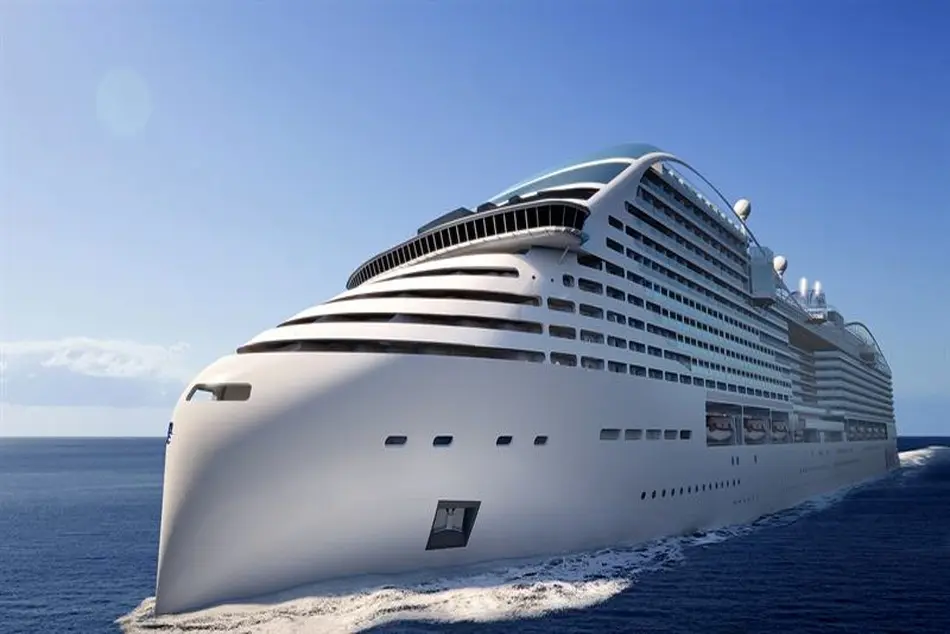Cruise Shipping’s Historic Rebound
Battered by Covid, the cruise industry was down but not out. Today it is setting records in passenger count + the size and cost of a new fleet.

Battered by Covid, the cruise industry was down but not out. Today it is setting records in passenger count + the size and cost of a new fleet.
Post-Pandemic, the fortunes of the big cruise companies have brightened dramatically. A late December, 2024 earnings release from Carnival Corporation & plc (NYSE: CCL), encompassing brands including Carnival Cruise, Holland America, Cunard, Princess Cruises and others, says it all: “This has been an incredibly strong finish to a record year,” said CCL’s CEO Josh Weinstein, in its statement. “Revenues hit an all-time high driven by a strong demand environment that we elevated throughout the year, enabling us to outperform our initial 2024 guidance by $700 million and deliver nearly $2 billion more to the bottom line, year-over-year,” with overall revenue surging above $25 billion in 2024.
And CCL is not done: “2025 is shaping up to be another banner year …” said Weinstein.
Rebounding from Covid-19
The pandemic, which began abruptly in March 2020, sent the cruise industry, among others, into a seeming death spiral, with many cruise ships sent to the scrap yard and cruise companies bleeding cash. During the Pandemic era with its vessel anchored outside the big ports, the cruise industry’s debt load ballooned, as the companies needed to keep themselves afloat (as well as financing newbuilds that were on order). Consider the case of CCL: at end 2019, CCL’s long-term debt stood at just under $10B. A year into the pandemic, the measure had soared to $26.5B on the balance sheet; fast forward another year, February, 2022, and the CCL balance sheet showed just under $30 billion of long term debt, reaching a zenith around $35 billion in January, 2023, before the tide began turning.
But by mid-2022, when the Center for Disease Control (CDC) ended its Covid-19 restrictions, the industry that had been brought to a standstill (with passenger counts of 5.8 million and 4.8 million in 2020 and 2021, respectively compared to 29.7 million in 2019), the comeback started.
Its turnaround didn’t even take three years, as Cruise Lines International Association (CLIA) noted in its mid-2024 “State of the Cruise Industry” report that passenger counts had recovered from pre-Pandemic levels with 31.7 million passengers sailing in 2023, with CLIA was forecasting 40 million total passengers sailing annually by 2027.
To that end, the cruise majors are girding up for this increased demand with new ship orders. Royal Caribbean Group (NYSE: RCL) placed an order with Meyer Turku for a fourth Icon class 7,600-passenger ship, which coincided with initiation of options for two additional vessels with an anticipated 2027 delivery. The lead ship in the Icon class, the LNG-fueled ICON OF THE SEAS, cost around $1 billion, and was delivered at the beginning of 2024. Two others, STAR OF THE SEAS, and a still un-named vessel, are set for deliveries in Q3 2025, and Q2, 2026, respectively. A smaller “Xcel Class” vessel, the 3,950-passenger CELEBRITY XCEL, is under construction at Chantiers de l’Atlantique with an anticipated Q4 2025 delivery.
In late January 2025, RCL announced another order with the French yard, for an Xcel class vessel (to be methanol fueled) with 2028 delivery.
The Chantiers yard, in Saint-Nazaire, France, delivered an LNG-powered “Oasis Class” vessel, the UTOPIA OF THE SEAS, with a maximum capacity of 7,000 passengers, to the company in mid-2024. In regulatory filings RCL said that: “To finance the delivery, we borrowed a total of $1.5 billion under the committed financing agreement, resulting in an unsecured term loan which is 100% guaranteed by BpiFrance Assurance Export.” RCL had noted in an October 2024 regulatory filing that: “The aggregate cost of our ships on order … not including any ships on order by our partner brands [TUI Cruises and Hapag Lloyd Cruises], was approximately $5.9 billion.”
Cruise Ship Building Takes Off
Among the biggest news on the ordering front was CCL’s blockbuster mid-2024 three ship order from Fincantieri in Italy. The almost 230,000 gt vessels with a passenger capacity of nearly 8,000 passengers are to be delivered in 2029, 2031 and 2033. According to the yard, these vessels, to sail under the Carnival Cruise brand, will be “…a new class of LNG powered vessels.”
LNG fueling, with CCL’s Aida brand debuting in 2015, has achieved significant market penetration in the cruise sector. In announcing the new order, company Weinstein stressed the vessels’ “…latest technological advancements to minimize our environmental footprint…” While the price of the order has not been announced publicly, the rumor mill, earlier in the year, had put a price-tag of $1.25 billion per vessel on the order.
Fincantieri had delivered another LNG fueled vessel, SUN PRINCESS, with a capacity of 4,300 passengers, to Princess Cruises (a brand within CCL) in late February, 2024 from its Monfalcone yard, following QUEEN ANNE (3,000 passengers, under the Cunard brand), delivered several months later from its Marghera facility. Earlier in the year, the LNG fueled CARNIVAL JUBILEE a 6,400 passenger (Excel-class, with a homeport in Galveston, Texas) had been delivered from Meyer Werft in Papenburg. During 2024, Carnival Corporation placed orders for two more Excel-class ships to be built at Meyer Werft, for delivery in 2027 and 2028, ending a Pandemic-induced drought of new orders. These vessels will also be LNG powered.
At Norwegian Cruise Line Holdings (NYSE: NCLH), with its eponymous Norwegian International, Oceania, Seven Seas and Regent brands, NORWEGIAN AQUA (with double-occupancy capacity pegged at 3,550 passengers and featuring the industry’s first slide coaster) is due for delivery from Fincantieri in March, 2025. Following a trans-Atlantic repositioning voyage, it will cover itineraries along the U.S. East Coast to Bermuda and the Caribbean. A sister, NORWEGIAN LUNA, will be joining NCLH’s fleet in Spring, 2026.
NCLH’s Oceania Cruises line is set to see delivery of 1,450 passenger capacity ships, with eyes focused on ALLURA (being built at a Fincantieri facility) set to commence voyages in Summer, 2025. The parent company said, in a mid-2024 release, that: “…Oceania Cruises has two additional ships on order scheduled for delivery in 2027 and 2028 or 2029.” The Regent Seven Seas Cruises fleet will be seeing deliveries of two hybrid powered vessels with 850 passenger capacity, SEVEN SEAS PRESTIGE (in 2026) and an unnamed sister due for 2029 delivery.
More Ships v. More Debt: Walking a Fine Line
At CCL, its discussion of the ordering for increasingly larger newbuilds, in a late 2024 regulatory filing, shines a spotlight on the need for balance and moderation in growth, as it was noted: “The company is following through on its measured capacity growth strategy of one to two ships per year on average, including just three ships scheduled for delivery through 2028. This will enable the company to utilize its substantial free cash flow to strategically improve its balance sheet by significantly reducing its leverage levels over the next several years.”
For the major cruise companies, balancing the capital costs of bigger ships (which will bring in revenue) with continued management of outstanding debt (which has costs) is critical. Financial reporting from NCLH (the smallest of the “Big Three”) provides an insight into the importance of debt in cruise ship finance generally. Its end September, 2024 balance sheet showed overall assets of roughly $19.8B, of which around $18B was property/equipment, and “other long-term assets”. The capital stack shows long term debt totaling $13.4 (including the current portion); down from nearly $14.1 at year-end 2023. Borrowings connected with two vessels for Oceania, and two for Seven Seas (both brands within NCLH) being constructed at Fincantieri with export guarantees from the Italian export credit agency SACE S.p.A.
Disney Cruise Line, part of the much larger Walt Disney Company (NYSE:DIS) with a five vessel fleet (and four ships already set for delivery between 2025-2027), is continuing its expansion. The $1.1 billion, 4,000-passenger LNG-powered DISNEY TREASURE began service in December 2024, with DISNEY DESTINY, a sistership to follow later in 2025. Powered by MAN 2V 51/60DF engines, Meyer Werft Papenburg is the builder of both vessels. In Summer, 2024, Disney announced a multi-ship order from the same German builder, with deliveries of the LNG powered vessels out to 2031.
Finally, the privately owned (but heavily resourced) MSC Cruises, is now operating nearly two dozen cruise vessels and competing with the “Big Three” + Disney. In Spring 2025, the company’s 6800+ passenger MSC WORLD AMERICA, being completed at Chantiers de l’Atlantique, will join its sister MSC WORLD EUROPA (which delivered in late 2022) in cruising out of Miami. Both ships are LNG powered, with the 2025 addition using LNG-fed solid oxide fuel cell providing a portion of the electricity onboard and fitted for shore power. Another sister, MSC WORLD ASIA, is slated for a mid-2026 delivery from the yard in Saint Nazaire, before shifting over to its base in Miami.

